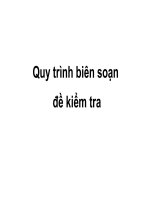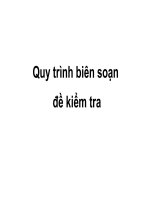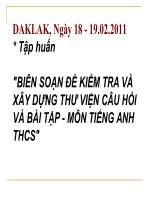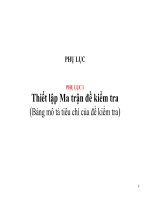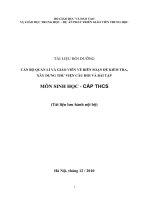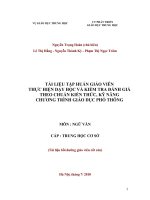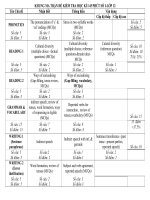Tập huấn biên soạn Ma trận - Đề KT Tiếng Anh 2011
Bạn đang xem bản rút gọn của tài liệu. Xem và tải ngay bản đầy đủ của tài liệu tại đây (291.69 KB, 22 trang )
Daklak, 18 – 19.02.2011
KĨ THUẬT BIÊN SOẠN ĐỀ
KIỂM TRA
1. Kĩ thuật biên soạn câu hỏi Từ vựng/Vocabulary questions
2. Kĩ thuật biên soạn câu hỏi Ngữ pháp/Grammar questions
3. Kĩ thuật biên soạn câu hỏi Đọc hiểu/Reading questions
4. Kĩ thuật biên soạn câu hỏi Viết/Writing questions
5. Đánh giá đề kiểm tra / Evaluating the tests
6. Kiểm tra đánh giá theo chuẩn Kiến thức Kỹ năng
7. Các kĩ năng đặt câu hỏi
4. Kĩ thuật biên soạn câu hỏi Viết/
Writing questions
* Limited response
1. Sentence combining:
- Combining by adding a connective: and, but, however,
nevertheless, so, consequently, therefore…
E.g.: 1) He likes ice cream but he won't eat any.
2) She didn't feel well today so she didn't go to work.
- Combining sentences by having students make internal
changes in the grammar
E.g.: 1) Some people come late. They will not get good seats. (that)
(Answer: People that come late will not get good seats.)
2) I am surprised. Nobody likes her. (It - that)
(Answer: It surprises me that nobody likes her)
4. Kĩ thuật biên soạn câu hỏi Viết/
Writing questions
* Limited response
2. Sentence expansion
E.g.: 1) The (______) man hurried (______) to the
(_________) horse.
(Answer: The old man hurried out to the frightened horse.)
2) His decision (_____) surprised everyone
(______).
(Answer: His decision to quit his job surprised everyone
that knew him.)
4. Kĩ thuật biên soạn câu hỏi Viết/
Writing questions
3. Sentence reduction
* Limited response
Ex:
-
He told us about a man who had a wooden leg. (with)
(Answer: He told us about a man with a wooden leg.)
- Her father, who is certainly the stingiest man I know,
wouldn't let us borrow his car. (one word)
(Answer: Her stingy father wouldn't let us borrow his car.)
4. Kĩ thuật biên soạn câu hỏi Viết/
Writing questions
Advantages of Limited-Response Items
1.These are generally quite easy to construct.
2.These are suitable for students with limited ability in
English.
3.Except for the open-ended variety, these are rather
objective for a writing-related task.
Limitations of Limited-Response Items
1.These do not measure actual writing skill.
2.These can be rather slow to correct-especially the open-
ended variety.
4. Kĩ thuật biên soạn câu hỏi Viết/
Writing questions
* Guided writing
E.g.: Directions: The following sentences contain errors in
mechanics. But there are no spelling errors. Find the part of the
sentence where the mistake occurs. Then circle the letter of that
part.
1) (A) We sent for / (B) a repairman to take / (C) a look at the /
(D)telephone. In the office where I work.
2) (A) The Doctor told / (B) the young soldier (C) to drive south
through the valley / for supplies at the nearest city.
In 1, the error occurs in part "D"; "in the office where I work" is not a
complete sentence; this sentence "fragment" needs to be joined to the
main sentence.
In 2, the error occurs in part "A"; the word "doctor" should not be
capitalized unless used with a person's name (Dr. Adams), and then it
would be abbreviated.
4. Kĩ thuật biên soạn câu hỏi Viết/
Writing questions
* Guided writing
One way is to find a good unified paragraph and then add a
sentence that is unrelated. Students have to find the sentence (or
sentences) that don't fit. Here is an example:
(1) Some people think they have an answer to the troubles of
automobile crowding and dirty air in large cities. (2) Their
answer is the bicycle, or "bike." (3) In a great many cities,
hundreds of people now ride bicycles to work every day. *(4)
Some work with their hands while others depend mostly on their
brains while working. (5) A group of New York bike riders claim
that if more people rode bicycles to work there would be less
dirty air in the city from car engines.
4. Kĩ thuật biên soạn câu hỏi Viết/
Writing questions
* Guided writing
Find or write a well-organized paragraph with clear transition
words. Then scramble the sentences. Students have to put the
sentences back into their original order. Here is an example:
(1) So on April 18,1775, he started across the Charles River, where he
planned to wait for a signal from a friend.
(2) The American Revolution was a citizens' revolution in which
ordinary men took a large part. (3) He was living in Boston when
British troops arrived to keep people under control. (4) When he saw
the lights, he jumped on his horse and rode through the countryside
warning the people that they must fight at daybreak. (5) One such man
was Paul Revere, a silver worker. (6) Like others, Revere thought the
British troops would move from Boston against the villagers.(7) That
night after reaching the other side, Revere saw hi friend's lantern
signals.
(Key: 2, 5, 3,6, 1,7,4)'
4. Kĩ thuật biên soạn câu hỏi Viết/
Writing questions
* Building from a Paragraph Outline
One kind of paragraph outline used for testing writing controls
the content and the grammar. It takes the following form:
I / buy / new white swimsuit / I forget I bring / I / mad /
Becky / mother / take / we / shop / Monday night / I find /
pretty blue / not expensive. / I start / pay / wallet / gone /I /
borrow / money / Becky / mother / I / certainly / upset
I bought a new white swimsuit, and then I forgot to bring it. I
was really mad. But Becky's mother took us shopping Monday
night, and I found a pretty blue one. It was not very expensive. I
started to pay for it, and my wallet was gone! I borrowed some
money from Becky's mother, but I was certainly upset.
4. Kĩ thuật biên soạn câu hỏi Viết/
Writing questions
* Building from a Paragraph Outline
E.g.: Directions: Write a paragraph of about seventy-five words
describing a store or business that you know very well. Base your
paragraph on answers to the following questions:
What is it called?
When did it start to do business?
How many employees does it have?
What do the employees have to do?
Does it have a lot of customers/clients? Why (not)?
Why do you choose to go there rather than somewhere else?
Is it a good example of what such a store business should be?
Students’ writing can be started like this:
In my neighborhood there is a . . .
4. Kĩ thuật biên soạn câu hỏi Viết/
Writing questions
Advantages of Guided-Writing Tests
1.Guided-writing tests are rather quick and easy to construct.
2.Because they require an active rather than a passive response,
guided testing techniques give the appearance of being an effective
measure of writing.
3.Guided-writing tests provide appropriate control for those
students who are not ready to write on their own.
Limitations of Guided-Writing Tests
1.Guided-writing tests do not measure ingredients such as
organization found in extended writing.
2. Guided writing of the paragraph-outline variety is often rather
time consuming and difficult to grade.
3. Guided writing of the paragraph-outline variety is difficult to
score with real consistency.
4. Kĩ thuật biên soạn câu hỏi Viết/
Writing questions
* Free Writing
The following test item looks at upper-intermediate letter-
writing skills:
E.g.: Direction: You need a job for the summer. You have
just read a "Help Wanted" advertisement for teenage
workers (reception, dining room, and cleanup) at the Grand
Canyon Lodge in Arizona. Address: U.S. Forest Service,
Grand Canyon Lodge, Box 1128, North Rim, Arizona 82117.
Write a business letter; Indicate the position applied for.
Describe your qualifications, such as your age, language
background, travel, and personality characteristics.
Indicate when you will be available and how long you can
work.
4. Kĩ thuật biên soạn câu hỏi Viết/
Writing questions
Advantages of Free-Writing Approaches
1.Despite in limitations, this is an important, sound measure
of overall writing ability.
2.This can have a good effect on instruction: Students will be
more motivated to write in and out of class, knowing that
their test will be an actual writing task.
3.There is virtually very little chance of getting a passing
grade on a free-writing test by cheating.
Limitations of Free-Writing Approaches
1.Grading of free writing tends to lack objectivity and
consistency.
2.Free writing is time consuming to grade.
5. Đánh giá đề kiểm tra / Evaluating the tests
* Preparing an Item Analysis
An item analysis tells us basically three things: how difficult
each item is, whether or not the question "discriminates" or
tells the difference between high and low students, and
which distractors are working as they should.
- Difficulty Level
- Discrimination Level
- Distractor Evaluation
5. Đánh giá đề kiểm tra / Evaluating the tests
* Difficulty Level
(1) Add up the number of high students with the correct answer
(to question number one, for example). (2) Then add up the
number of low students with the correct answer.
(3) Add the sum found in steps 1 and 2, together. (4) Now divide
this figure by the total number of test papers in the high and low
groups combined.
High Correct + Low Correct or Hc + Lc
Total Number in Sample N
An example will illustrate how to do this. Let's assume that 30
students took the test. We correct the tests and arrange them in
order from high to low. Then we divide them into three stacks.
5. Đánh giá đề kiểm tra / Evaluating the tests
We would have 10 in the high group and 10 in the low group.
We set the middle 10 aside. The total number (N) in the sample
is therefore 20. We now mark on the sheet how many high
students selected A, B, C, or D; and how many low students
marked these choices. (If the item is left blank by anyone, we
mark the "X" line.) Below is the tally for item 1. Note that "B" is
the right answer for this question. We see that 5 in the high
group and 2 in the low group got item number 1 correct.
* Difficulty Level
Thus,
5. Đánh giá đề kiểm tra / Evaluating the tests
* Discrimination Level
(1) Again find the number in the top group who got the item
right. (2) Find the number in the bottom group who got it right.
(3) Then subtract the number getting it right in the low group
from the number getting it right in the high group. (4) Divide this
figure by the total number of papers in the high and low groups
combined.
A formula for this would be:
High Correct - Low Correct or Hc - Lc
Total Number in Sample N
Thus,
5. Đánh giá đề kiểm tra / Evaluating the tests
* Distractor Evaluation
(1) Included sometimes is an item that was drilled heavily
in class – an item that almost everyone has mastered.
Therefore, the answer is obvious; the distractors cannot
"distract."
(2) Sometimes a well-recognized pair is used (this/these,
is/are, etc.). Even though not everyone has control of these
yet, students know that one of the two is the right answer;
no other choice seems likely. Here we need to choose
another test format. (3) A third cause is the use of obviously
impossible distractors: ("Did he do the work?"/*A. Yea, he
did. B. Birds eat worms. C. Trains can't fly.).
5. Đánh giá đề kiểm tra / Evaluating the tests
Bài tập / tasks
6. Kiểm tra đánh giá theo chuẩn KTKN
7. Các kĩ năng đặt câu hỏi
Knowledge
Questions like: What are the health benefits of eating apples?
Comprehension
Questions like: Compare the health benefits of eating apples vs. oranges.
Application
Questions like: Which kinds of apples are best for baking a pie, and why?
Analysis
Questions like: List four ways of serving foods made with apples and explain
which ones have the highest health benefits. Provide references to support your
statements.
Synthesis
Questions like: Convert an "unhealthy" recipe for apple pie to a "healthy" recipe
by replacing your choice of ingredients. Explain the health benefits of using the
ingredients you chose vs. the original ones.
Evaluation
Questions like: Do you feel that serving apple pie for an after school snack for
children is healthy? Why or why not?
